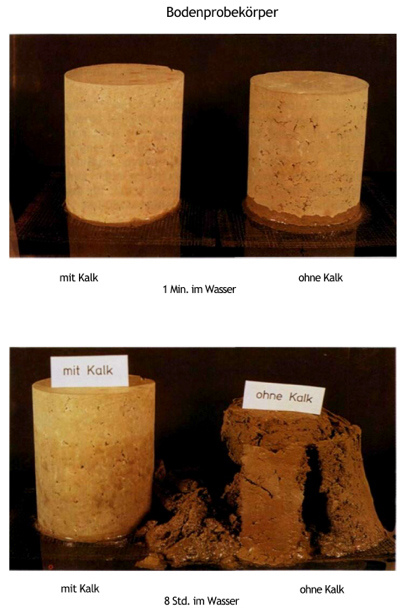Soil treatment with lime is applicable everywhere, where there is the prompt necessity to build on wet soil
Today, besides the classic road and track-renewal operations, lime is applied in different building sectors, for example:
- Stabilizations of subsoil for the increase of soil pressure under the building
- Laying of all types of pipelines (trench reinstatement)
- Dams in hydraulic engineering (river dikes, canal construction, water basins)
- Slope stabilization (prevention or elimination of landslides)
- Transportation roads on building sites
- Stabilization with limestone poles (i.e. deep improvements in the substructure or underfloor)
Since soils can be used as construction material through lime treatment, massive cost savings are reached. A soil replacement is no longer required and roads are not unnecessarily strained.
Particular advantages of soil improvement with lime are:
- Continuous building implementation
- Immediate practicability of the working planum
- No standstill in case of bad weather (except with heavy rainfalls or frost)
- The required degree of compaction is easily obtained
Particular advantages of soil stabilization with lime are:
- Increase of bearing loads and permanent improvement of frost resistance
- Reduction of damages in the superstructure in the long-term behavior of a road construction
Lime acts quickly through the binding of water and in the long-term through a pozzolanic soil stabilization
Very complex mechanical processes occur in the soil. From experience, fine-grained soils are suitable for the lime treatment.
Short and long-term reactions are crucial for the impact. The short reactions of lime bind the capillary water in the soil by the formation of calcium hydroxide:
- CaO + H2O -> Ca(OH)2 + heat
Hereby a crumb formation is achieved, that improves the plastic properties. The soil becomes better solidifiable, also with higher water contents. As well the bearing capacity is increased (see figure 1).
Figure 1: comparison between soil samples with and without lime after one minute and after eight hours in water. The soil treatment with lime improves the bearing capacity and the water resistance significantly.
With the long-term reaction, the calcium hydroxide reacts with clay minerals in the soil and leads to:
- Volume stability,
- Long-term increase of resistance,
- Durable load-bearing strength,
- Frost resistance.
The increase in solidity over a longer period of time is caused by a pozzolanic reaction between the lime and the clay minerals of the soil over many months. The result is a hydraulic stabilization. However, it develops that slowly, that the lime-soil mixture remains workable for about four days. A lime-treated layer of soil can be even longer profiled, without causing any damages.
Lime in soil enhances its buffer capacity and thus works against possible acidification.
KFN offers the perfect lime products for the soil treatment
The success of soil treatment is evidenced among other things by the level of reduction of the water content and is influenced by:
- Number of cycles of mixture
- Type of weather (wind, humidity, air temperature),
- Type and quantity of lime.
Our lime products show optimum characteristics for the use in soil treatment:
- Nekasol 2 reacts very fast and can be worked very well into the soil thanks to its fine granularity. Nekasol 2 fulfills the requirements on building lime for the highest category CL 90-Q (R5, P1). Nekasol is particularly suitable for wet soils thanks to its high reactivity.
- Nekapur 2 also exceeds significantly the building lime requirements CL 90-S and is generally applied only with very dry soils.
More information
=>Instructions for soil treatment with lime
=>Brochure soil treatment
=>Link to the KFN website,

